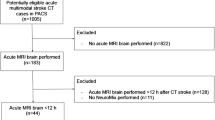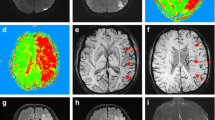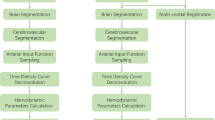Abstract
Introduction
We attempted to determine the most appropriate combination of magnetic resonance (MR) images that can accurately detect and discriminate between asymptomatic infarction and deep white matter hyperintensity (DWMH); these lesions have different clinical implications and are occasionally confused.
Materials and methods
We performed an observer performance analysis using cerebral MR images of 45 individuals with or without asymptomatic small white matter infarction and/or mild DWMH who participated in a physical checkup program at four institutions. Six observers interpreted whether infarction and/or DWMH existed in combinations of two or three image types of the T1-weighted images (T1WI), T2-weighted images (T2WI), and fluid-attenuated inversion recovery (FLAIR) images. The observers’ performance was evaluated with a receiver operating characteristic (ROC) analysis.
Results
The averaged area under the ROC curve (Az) for detecting a infarction was significantly larger in the combination of all the three image types (0.95) than that in any combinations of the two image types (T1WI and FLAIR images, 0.87; T2WI and FLAIR images, 0.85; T1WI and T2WI, 0.86). The Az for detecting DWMH was significantly smaller in the combination of T1WI and T2WI (0.79) than that in other image combinations (T1WI and FLAIR, 0.89; T2WI and FLAIR, 0.91; T1WI, T2WI, and FLAIR, 0.90).
Conclusion
The combination of T1WI, T2WI, and FLAIR images is required to accurately detect both small white matter infarction and mild DWMH.


Similar content being viewed by others
References
Bernick C, Kuller L, Dulberg C, Longstreth WT, Manolio T, Beauchamp N, Price T (2001) Silent MRI infarcts and the risk of future stroke: the Cardiovascular Health Study. Neurology 57:1222–1229
Vermeer SE, Hollander M, van Dijk EJ, Hofman A, Koudstaal PJ, Breteler MM (2003) Silent brain infarcts and white matter lesions increase stroke risk in the general population: the Rotterdam Scan Study. Stroke 34:1126–1129
van der Flier WM, van Straaten CW, Barkhof F, Verdelho A, Madureira S, Pantoni L, Inzitari D, Erkinjuntti T, Crisby M, Waldemar G, Schmidt R, Fazekas F, Scheltens P (2005) Small vessel disease and general cognitive function in nondisabled elderly: the LADIS study. Stroke 36:2116–2120
Pantoni L, Poggesi A, Basile AM, Pracucci G, Barkhof F, Chabriat H, Erkinjuntti T, Ferro JM, Hennerici M, O'Brien J, Schmidt R, Visser MC, Wahlund LO, Waldemar G, Wallin A, Inzitari D (2006) Leukoaraiosis predicts hidden global functioning impairment in nondisabled older people: the LADIS (leukoaraiosis and disability in the elderly) Study. J Am Geriatr Soc 54:1095–1101
Braffman BH, Zimmerman RA, Trojanowski JQ, Gonatas NK, Hickey WF, Schlaepfer WW (1988) Brain MR: pathologic correlation with gross and histopathology. 1. Lacunar infarction and Virchow–Robin spaces. AJR 151:551–558
Fazekas F, Chawluk JK, Alavi A, Hurtig HI, Zimmerman RA (1987) MR signal abnormalities at 1.5T in Alzheimer’s dementia and normal aging. AJR 149:351–356
Metz CE, Herman BA, Shen JH (1998) Maximum-likelihood estimation of receiver operating characteristic (ROC) curves from continuously-distributed data. Stat Med 17:1033–1053
Longstreth WT, Bernick C, Manolio TA, Bryan N, jungreis CA, Price TR (1998) Lacunar infarcts defined by magnetic resonance imaging of 3660 elderly people: the Cardiovascular Health Study. Arch Neurol 55:1217–1225
Longstreth WT, Dulberg C, Manolio TA, Lewis MR, Beauchamp NJ, O’Leary D, Carr J, Furberg CD (2002) Incidence, manifestations, and predictors of brain infarcts defined by serial cranial magnetic resonance imaging in the elderly: the Cardiovascular Health Study. Stroke 33:2376–2382
Vermeer SE, den Heijer T, Koudstaal PJ, Oudkerk M, Hofman A, Breteler MMB (2003) Incidence and risk factors of silent brain infarcts in the population-based Rotterdam Scan Study. Stroke 34:392–396
de Leeuw FE, de Groot JC, Achten E, Oudkerk M, Ramos LM, Heijboer R, Hofman A, Jolles J, van Gijn J, Breteler MM (2001) Prevalence of cerebral white matter lesions in elderly people: a population based magnetic resonance imaging study. The Rotterdam Scan Study. J Neurol Neurosurg Psychiatr 70:9–14
Longstreth WT, Arnold AM, Beauchamp NJ Jr, Manolio TA, Lefkowitz D, Jungreis C, Hirsch CH, O’Leary DH, Furberg CD (2005) Incidence, manifestations, and predictors of worsening white matter on serial cranial magnetic resonance imaging in the elderly: the Cardiovascular Health Study. Stroke 36:56–61
Awad IA, Johnson PC, Spetzler RF, Hodak JA (1986) Incidental subcortical lesions identified on magnetic resonance imaging in the elderly. II. Postmortem pathological correlations. Stroke 17:1090–1097
Chimowitz MI, Estes ML, Furlan AJ, Awad IA (1992) Further observations on the pathology of subcortical lesions identified on magnetic resonance imaging. Arch Neurol 49:747–752
Matsusue E, Sugihara S, Fujii S, Ohama E, Konishita T, Ogawa T (2006) White matter changes in elderly people: MR-pathologic correlations. Magn Reson Med Sci 5:99–104
Shinohara Y, Tohgi H, Hirai S, Terashi A, Fukuuchi Y, Yamaguchi T, Okudera T (2007) Effect of the Ca antagonist nilvadipine on stroke occurrence or recurrence and extension of asymptomatic cerebral infarction in hypertensive patients with or without history of stroke (PICA study). Cerebrovasc Dis 24:202–209
Bokura H, Kobayashi S, Yamaguchi S (1998) Distinguishing silent lacunar infarction from enlarged Virchow-Robin spaces: a magnetic resonance imaging and pathological study. J Neurol 245:116–122
Okuda T, Korogi Y, Shigematsu Y, Sugahara T, Hirai T, Ikushima I, Lian L, Takahashi M (1999) Brain lesions: when should fluid-attenuated inversion recovery sequences be used in MR evaluation? Radiology 212:793–798
Acknowledgment
Authors were grateful to Prof. Shigehiko Katsuragawa, Department of Radiological Technology, School of Health Sciences, Kumamoto University, for his generous help with the statistical analyses. This work was partly supported by a Grant for Leading Projects from the Japanese Society for Magnetic Resonance in Medicine and by a Grant-in-Aid for Science Research (18390256) and a Grant-in-Aid for Advanced Medical Science Research from the Ministry of Education, Culture, Sports, Science and Technology of Japan.
Conflict of interest statement
We declare that we have no conflict of interest.
Author information
Authors and Affiliations
Corresponding author
Rights and permissions
About this article
Cite this article
Sasaki, M., Hirai, T., Taoka, T. et al. Discriminating between silent cerebral infarction and deep white matter hyperintensity using combinations of three types of magnetic resonance images: a multicenter observer performance study. Neuroradiology 50, 753–758 (2008). https://doi.org/10.1007/s00234-008-0406-6
Received:
Accepted:
Published:
Issue Date:
DOI: https://doi.org/10.1007/s00234-008-0406-6




